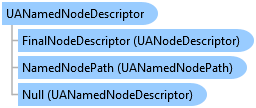

QuickOPC User's Guide and Reference
UANamedNodeDescriptor Class


'Declaration<ComVisibleAttribute(False)> <CLSCompliantAttribute(True)> <TypeConverterAttribute(System.ComponentModel.ExpandableObjectConverter)> <ValueControlAttribute("OpcLabs.BaseLib.Forms.Common.ObjectSerializationControl, OpcLabs.BaseLibForms, Version=5.72.465.1, Culture=neutral, PublicKeyToken=6faddca41dacb409", DefaultReadWrite=False, Export=True, PageId=10001)> <SerializableAttribute()> Public Class UANamedNodeDescriptor Inherits OpcLabs.BaseLib.Info Implements LINQPad.ICustomMemberProvider, OpcLabs.BaseLib.ComTypes._Info, OpcLabs.BaseLib.ComTypes._Object2, System.ICloneable, System.Runtime.Serialization.ISerializable, System.Xml.Serialization.IXmlSerializable
'UsageDim instance As UANamedNodeDescriptor
[ComVisible(false)] [CLSCompliant(true)] [TypeConverter(System.ComponentModel.ExpandableObjectConverter)] [ValueControl("OpcLabs.BaseLib.Forms.Common.ObjectSerializationControl, OpcLabs.BaseLibForms, Version=5.72.465.1, Culture=neutral, PublicKeyToken=6faddca41dacb409", DefaultReadWrite=false, Export=true, PageId=10001)] [Serializable()] public class UANamedNodeDescriptor : OpcLabs.BaseLib.Info, LINQPad.ICustomMemberProvider, OpcLabs.BaseLib.ComTypes._Info, OpcLabs.BaseLib.ComTypes._Object2, System.ICloneable, System.Runtime.Serialization.ISerializable, System.Xml.Serialization.IXmlSerializable
[ComVisible(false)] [CLSCompliant(true)] [TypeConverter(System.ComponentModel.ExpandableObjectConverter)] [ValueControl("OpcLabs.BaseLib.Forms.Common.ObjectSerializationControl, OpcLabs.BaseLibForms, Version=5.72.465.1, Culture=neutral, PublicKeyToken=6faddca41dacb409", DefaultReadWrite=false, Export=true, PageId=10001)] [Serializable()] public ref class UANamedNodeDescriptor : public OpcLabs.BaseLib.Info, LINQPad.ICustomMemberProvider, OpcLabs.BaseLib.ComTypes._Info, OpcLabs.BaseLib.ComTypes._Object2, System.ICloneable, System.Runtime.Serialization.ISerializable, System.Xml.Serialization.IXmlSerializable
This object encapsulates an idea of describing a node in the OPC UA address space either by
For example, when UANamedNodeDescriptor is used to describe a file object in OPC UA File Transfer, the NamedNodePath represents a directory and the NodeName represents the file name. The FinalNodeDescriptor refers directly to the file object node. For some operations, such as opening the file, the FinalNodeDescriptor is sufficient; but alternatively, you can specify the file by using a combination of the directory (NamedNodePath) and the file name (NodeName), and the component will resolve the directory and the file name to the actual file node. In some cases, the NamedNodePath and NodeName are necessary, because the operation requires not just knowing the final node descriptor, but also the node of its parent. This happens, for example, when a file or directory is being moved or deleted.
System.Object
OpcLabs.BaseLib.Object2
OpcLabs.BaseLib.Info
OpcLabs.EasyOpc.UA.Navigation.UANamedNodeDescriptor